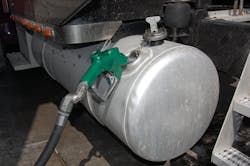Fuel tends to be either the second or third biggest cost in any fleet’s budget, switching spots with tires – depending on pump prices – with driver wages and benefits usually securing the top expense slot.
Yet the current decline in diesel prices – due in part to an ongoing slump in global oil prices – isn’t necessarily a boon to the bottom line of the trucking industry.
Indeed, according to John Larkin, managing director & head of transportation capital markets research for Stifel Financial, with trucking industry margins generally thin, and returns on invested capital relatively low, motor carriers are actually somewhat reliant on profits earned on fuel surcharge revenue.
Larkin further argues that LTL carriers with better-than-average load factors and TL carriers with better than average fuel efficiency can actually bolster their margins with the profits earned on fuel surcharge revenue.
That’s but one reason why managing fuel expenses is so important, even when fuel prices are low, explains Brian Carlgren, president of fuel card program provider TransConnect Services.
Fleet Owner had a chance to catch up with Carlgren and ask him a few questions about why fuel management programs are so important in trucking these days – especially for small- to mid-sized motor carriers.
We’ll start with the ‘devil’s advocate’ question: Fuel prices have been very low over the past year or so. Why do fleets need to manage their fuel purchases? Why are fuel management programs important?
Do you ever notice how quickly freight rates drop when fuel prices do? Or how slowly freight rates go back up when fuel prices increase? Successful carriers know that having discounts in place is important no matter what the price of fuel is. When fuel prices drop, freight rates drop. Carriers need to be mindful that freight rates drop a lot faster when fuel prices are low. So having a 20 cent to 30 cent per gallon spread on your fuel is just as important when fuel is down. Fuel is variable and volume is too, you can’t base your business on one without considering the other.
Everyone talks about fuel cards and fuel programs. How do they help fleets, especially smaller ones? What do such cards provide that fleets can’t do by themselves?
Small fleets don’t have the same negotiating power as larger fleets because they don’t use as much fuel. Most fuel card programs are based on volume, so they’re more interested in signing on larger fleets because they’ll pump more gallons. A small carrier might get lesser fuel discounts if they can’t hit a certain amount of gallons, or their discounts may be based on a limited-time promotional program, where they get large discounts during the first three months, then the discounts drop significantly.
What we do is negotiate fuel discounts with truck stops on behalf of our entire client base, which has thousands of trucks – thus equaling a large fleet in a way. That means that even as a small trucking company or owner-operator, our clients get significant fuel discounts typically only available to those larger companies. We level the playing field between small to mid-sized trucking companies and larger fleets.
We also offer them management tools like our TransConnect Fuel Finder, which can help small- and mid-sized motor carriers better control their fuel costs by showing them fuel prices along any route.
How can tracking fuel expense data be helpful to fleets from a planning perspective? How does that information help them strategize their future better?
Successful carriers understand their fixed and variable costs. Fuel is such a big expense [that trucking] companies can’t adequately plan financially without accounting for fuel expenses. By planning routes and lanes to take advantage of fuel discounts and pricing, motor carriers can achieve a lower operating ratio. This, then, allows them to compete more aggressively on rates.
About the Author
Sean Kilcarr
Editor in Chief
Sean Kilcarr is a former longtime FleetOwner senior editor who wrote for the publication from 2000 to 2018. He served as editor-in-chief from 2017 to 2018.

